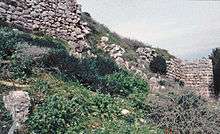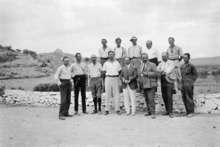Asine


Asine (/ˈæsɪniː/; Ἀσίνη) was an ancient Greek city of Argolis. It was mentioned by Homer as part of the kingdom of Diomedes, king of Argos. In 740 BC, the Argives destroyed the city because its citizens had helped the Spartans in their war against Argos. After the destruction, its citizens left and established the city of Asine in Messenia upon land that was given to them by the Spartans.[1]
Excavations made from 1922 by Swedish archaeologists led by Axel W. Persson (and involving the then Crown Prince Gustav Adolf of Sweden) found the acropolis of ancient Asine surrounded by a Cyclopean wall (much modified in the Hellenistic era) and a Mycenaean era necropolis with many Mycenaean chamber tombs containing skeletal remains and grave goods. Excavations have continued since the 1920s almost continuously under the Swedish Institute at Athens.[2] The site was last used as a fortified position by Italian troops during the second world war when machine gun nests were built.
References
- ↑

- ↑ Richard Stillwell, ed. Princeton Encyclopedia of Classical Sites, 1976: "ASINE Argolid, Greece"